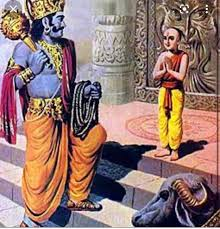Journey into the Nature of Death and Immortality
The Katha Upanishad: Journey into the Nature of Death and Immortality
The seer (Atman, Self) is not born, nor does he die, He does not originate from anybody, nor does he become anybody, Eternal, ancient one, he remains eternal, he is not killed, even though the body
is killed.... The Self (Atman), smaller than small, greater than great, is hidden in the heart of
each creature, Free from avarice, free from grief, peaceful and content, he sees the
supreme glory of Atman.
This Upanishad has two chapters (adhyayas), each with three sections (valli), thus a total of six sections. The first section has 29 verses, the second section 25 verses, and the third section has 17 verses in the first valli. The second valli opens with the fourth section which has 15 verses, while the fifth valli also has 15 verses and the final section has 17 verses. The Katha Upanishad is a combination of charming poetry, elevating mysticism, and profound philosophy. The subject of the mystery of death is introduced through the medium of an interesting anecdote; and the teaching of the Upanishad is presented in the form of a dialogue between a mere boy, Nachiketa, and Yama, the King of Death. With the text of the Upanishad in Devanagari, a lucid and faithful translation of the text and commentary, relevant notes, reference to quotations, and index to texts, this Upanishad is a must for all students of Vedanta.
The Upanishad explores the fundamental questions surrounding the nature of death and the possibility of immortality. It presents the story of Nachiketa, a young seeker who confronts the god of death, Yama, and engages in deep philosophical discussions. Through their dialogue, the Upanishad delves into the nature of the mortal body, the eternal nature of the Self, and the path to transcending death. It emphasizes the impermanence and fleeting nature of the material world. It highlights that all external objects and experiences are temporary and subject to decay and change. By recognizing the transitory nature of the external world, the seeker is urged to turn inward and seek the eternal essence within.
The Upanishad proclaims the existence of an immortal, eternal Self or Atman that transcends the cycle of birth and death. It teaches that this eternal essence is not affected by the changes and limitations of the material world. Through self-realization and the realization of the eternal Self, one can attain liberation from the cycle of transmigration and experience immortality. It elucidates the path to self-realization and the realization of the eternal Self and emphasizes the importance of spiritual knowledge, meditation, and contemplation in realizing one’s true nature. It also underscores the significance of a qualified spiritual teacher or guru who can guide the seeker on the path to self-realization. It stresses the importance of leading a righteous life and performing actions selflessly and in accordance with the divine will.
The Upanishad continues to be a revered text that offers profound spiritual guidance and wisdom. Its teachings inspire seekers to contemplate the nature of death, question the impermanence of the material world, and strive for self-realization. The concepts and insights presented in it have deeply influenced various philosophical and spiritual traditions, including Advaita Vedanta and the path of self-inquiry. It invites individuals to explore the eternal nature of the Self, transcend the fear of death, and discover the immortality that resides within. Its teachings inspire seekers to embrace a life of spiritual inquiry, ethical conduct, and self-realization. By delving into the profound wisdom of this Upanishad, individuals can embark on a transformative journey towards self-discovery and the realization of their eternal essence.

Comments
Post a Comment